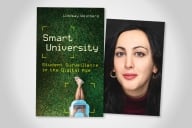You have /5 articles left.
Sign up for a free account or log in.

Amy Brand, director of MIT Press, is leading a new Direct to Open initiative.
MIT Press
The MIT Press, one of the world’s largest university presses, plans to publish its entire slate of spring 2022 monographs and edited collections on an open-access basis. The move is a major development for the larger open-access movement and a model that scholars and librarians say could be revolutionary for cash-strapped libraries, university presses and a dwindling number of humanities scholars.
The plan relies on commitments from more than 160 libraries and consortia whose pledges allowed MIT Press to reach 50 percent of the participation threshold it set against its three-year target. The press has extended a deadline for further commitments from additional institutions to June 30, 2022. MIT Press leaders say enthusiasm for its Direct to Open (D2O) effort, launched in April, has been so strong that they intend to share a white paper in January describing how the model works so other university presses can replicate it.
Amy Brand, director of MIT Press, calls D2O a much-needed alternative to traditional market-based scholarly business models. Monograph sales today are typically in the range of 300 to 500 units, down from 1,500 to 1,700 units per title in the 1990s, meaning that publishing now demands internal subsidies from institutions or philanthropies. Much of this downward trend in purchasing was driven by the increase in scientific journals and the high percentage of acquisition budgets they now account for, Brand said. The desire among librarians to buy digital copies of monographs has only further eroded the sales numbers.
By getting institutions to commit ahead of time to supporting its catalog, MIT Press is able to meet its revenue needs and then allow everyone else to access its work for free. Some observers worried about how the model will endure if a small group of benefactors stops underwriting free access for everyone else. But Brand said the model is not “purely altruistic,” since paying customers will be given access to hundreds of backlist books that are not openly available.
She said she was motivated to try the model because MIT Press “wanted to be a first mover” and “an inspiration for other presses about what might be possible in fixing what has been a very broken model for a long time.” Brand said she is considering inviting other publishers to join the D2O program.
“You can imagine a platform in which a number of university presses have implemented this model and are approaching libraries as a collaboration,” she said.
Brand said the new model includes a provision in which MIT Press returns money to individual institutions if enough partners come aboard to create a surplus.
“That’s the dream, right?” Brand said. “It creates more stability to have more partners.”
She said many libraries already have agreed to three-year commitments. MIT Press plans to document impact by sharing usage, number of downloads and other metrics illustrating how the open-access model has benefited society at large.
A range of institutions, including colleges within big state university systems and smaller, private liberal arts colleges, are among the 160-plus early participants. These institutions include Bryn Mawr College Libraries, Caltech Library, Carnegie Mellon University Libraries, Emory Libraries, George Mason University, Johns Hopkins University Libraries, the University of Illinois at Urbana Champaign Library, the University of Iowa Libraries and the University of Maryland Libraries. The press also forged collective action agreements with the Big Ten Academic Alliance, the Center for Research Libraries, the Greater Western Library Alliance and Northeast Research Libraries, among others.
Greg Eow, president of the Center for Research Libraries and a former librarian at MIT who sits on the management board of the MIT Press, said he believes that early results show the three main players in the publication cycle—authors, presses and libraries—can work together and overcome cost pressures.
Eow said the D2O model is all the more vital at a time when humanities professors, university presses and libraries all face severe financial challenges from declining enrollments, the broader online open-access movement and universitywide budget crunches.
“If you look at the three-legged stool of scholarly production—author, press and library—every part of that stool is unhealthy,” Eow said. The MIT Direct to Open program "brings those three stool legs together to find a sustainable path ahead so everybody can climb out of this hole together. That’s the promise.”
Roger Schonfeld, a program director at Ithaka S+R, a not-for-profit organization that helps the academic community use digital technologies to preserve the scholarly record, hailed Brand as a visionary. But he wonders how the model will sustain itself, given the inherent free-rider problem in which a subset of institutions will support a larger nonpaying population.
“Now that they’ve got 160 participants, and they’ve announced that they’ve met that threshold, would any other library raise their hand and say we want to put money into the digital open access also?” Schonfeld asked. “What is the incentive for them to do so?” He called the considerations involved “almost game theory.”
Rick Anderson, head librarian at Brigham Young University, said several important questions have gone unasked in the D2O “narrative,” including whether supporting D2O is the best way for a given library to use its budget to provide access to knowledge. He said it will be critical for individual libraries to ask whether D2O is in harmony with their own institutional priorities. The more institutional funding a library plans to use to participate in D2O, Anderson said, the more important these questions will become.
Anderson said his biggest concerns with the model are its scalability and its incentive structure. He questioned whether the D2O model can be sustainable if it becomes the dominant model among scholarly book publishers. Anderson said he likes the idea of a highly diverse scholarly communication ecosystem that makes room for many different models of publishing, but D2O won’t be truly revolutionary until the model proves scalable.
Ultimately, D2O addresses the difficult reality that scholarly monographs are no longer in high demand, he said.
“From a somewhat crass perspective, this is simply another way of saying, ‘Not very many people want to buy and read scholarly monographs,’” Anderson said via email. “Taking the underwriting of monograph publishing out of the competitive marketplace—in other words, completely eliminating the element of reader demand from the publishing equation—and underwriting it with free-will offerings from libraries solves some problems but will inevitably create new ones. For example, it does leave one wondering if it might lead to the production of more and more books on more and more arcane and marginal topics.”
Allison Belan, director of strategic innovation at Duke University Press, said she will be watching closely to see if the MIT Press experiment proves durable. If it does, Belan said it could be a new path for funding open access to scholarly books not centered entirely within the science, technology, engineering and medical fields. To date, Belan said, open-access funding and models have developed largely in STEM disciplines, where more money is generally available. Brand’s “innovative and very fascinating experiment” could be particularly important for the humanities, Belan said, where it will offer an important new mechanism to ensure more scholarship is open.
But Belan said she does worry about what she called the “tragedy of the commons.”
She said shrinking library budgets could imperil the initiative over time. Some wealthier libraries have been focused on supporting open access to research, but that could change over time, particularly as costs rise without commensurate growth in budgets, she said.
Regardless of how emulated the model is over the long term, Belan cheered the fact that it will bring more eyeballs to scholarly monographs, which she called very specialized scholarship typically only reaching a small audience. She said it is exciting to think about how the model could be applied to a variety of other forms of scholarship. But she wondered if there will be a point where the same pool of well-funded libraries can no longer pay everyone else’s way.
“If this is emulated, how many different subscribe-to-open [and] pledge-to-open initiatives can be supported by the same pool of value-aligned and well-funded libraries?” she asked.
(Note: This article was updated to reflect that MIT Press intends to share a white paper about its open access model with other university presses in January, not in December as IHE was originally informed.)








